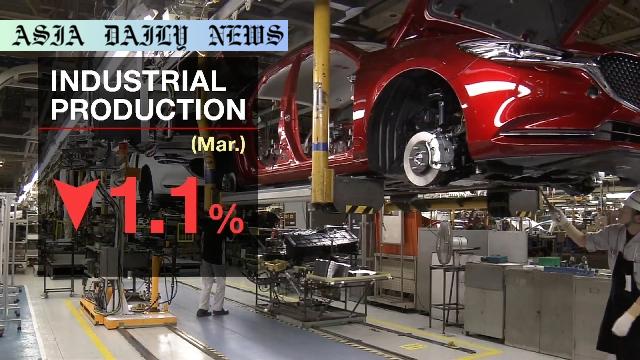Industrial Output: Japan experiences its first industrial production drop in two months, with automobile output falling nearly 6%.
Japan’s industrial production dropped 1.1% in March after two months of gains.
Automobile output fell nearly 6% due to reduced exports.
General and commercial machinery recorded a 5% decline.
The fiscal 2024 industrial index dropped 1.6% from the previous year.
Officials have yet to confirm links to US tariff policies but noted that companies are preparing countermeasures.

Overview of Japan’s Industrial Output Decline
Japan’s industrial output dropped by 1.1% in March, marking the first decline in two months, according to the Ministry of Economy, Trade, and Industry. This decrease follows a slight rebound in industrial production earlier this year. The recent decline has raised concerns within the economic sector as it hints at potential vulnerabilities in key areas of production, particularly the automobile industry. Among the 15 industries surveyed, 10 reported significant losses. This widespread downturn could pose challenges for short-term economic recovery as Japan attempts to stabilize industrial output post-pandemic.
Impact on Automobile Production
The automobile industry, which plays a pivotal role in Japan’s economy, showed a steep decline of nearly 6%, primarily attributed to waning export opportunities. As one of the country’s key drivers of industrial growth, the dip in vehicle output is concerning. The global demand for Japanese automobiles has been a crucial financial pillar for the economy. However, recent reports suggest that supply chain disruptions, fluctuating global markets, and increased competition are diminishing the sector’s performance. The reduced production has impacted both domestic and international stakeholders, with implications for global trade dynamics.
General Machinery and Broader Implications
In addition to automobiles, general and commercial machinery experienced a 5% drop in output, with specific declines noted in the production of conveyors used in domestic facilities. This reflects a broader slowdown in industrial machinery demand within Japan, raising questions about internal economic activities. Industries that rely on robust production of general machinery may struggle in the coming months, necessitating strategic adjustments from manufacturers and policymakers alike. This trend underscores the need for a deeper evaluation of domestic factors impacting industrial demand.
Fiscal Year Declines and Long-Term Effects
For the fiscal year ending March 2024, the industrial production index declined by 1.6% compared to the previous fiscal year. This marks the third consecutive year of contraction in Japan’s industrial sector. Persistent challenges, such as fluctuating global supply chains, ongoing trade disputes, and post-pandemic recovery difficulties, continue to weigh heavily on industrial activities. Officials have noted that while direct effects from the United States’ tariff policies have not been confirmed, companies are preparing countermeasures to mitigate potential risks from future trade conflicts.
Future Outlook: Concerns and Opportunities
Looking ahead, Japan faces both challenges and opportunities. While the decline in industrial output raises immediate economic concerns, it also offers an opportunity for industries to innovate and adapt. Policymakers must explore strategies to improve domestic production capabilities and strengthen international trade partnerships. Moreover, diversifying industrial outputs and focusing on emerging technologies could provide a more sustainable path for growth. By fostering resilience within its industries, Japan can address current challenges and position itself for long-term stability and expansion.



Commentary
The Complexities of Industrial Output in Japan
The recent decline in Japan’s industrial output raises important issues about the underlying health of its manufacturing sector. While a single month’s decline may not be catastrophic, it is part of a larger trend, with fiscal 2024 marking the third consecutive year of reduced production. This consistent downturn should be a wake-up call for both policymakers and industry leaders to reassess and implement innovative strategies.
Challenges in the Automobile Industry
The automobile industry’s nearly 6% drop in production represents a critical concern due to the sector’s role in Japan’s economy. A variety of factors, from reduced export demand to supply chain issues, have contributed to this decline. The industry needs to rethink its approach, possibly by diversifying models or focusing on emerging markets to mitigate risks from traditional markets slowing down. Additionally, enhancing sustainability practices could attract a broader range of environmentally-conscious consumers.
Policy Adjustments and Future Prospects
Policymakers need to address a broader range of factors contributing to the industrial slump. Diversifying industries and supporting smaller businesses could create a more stable industrial landscape. Collaboration with international partners to address tariff issues and solidify supply chains could also enhance sectoral resilience. By focusing on long-term goals and sustainability, Japan has the opportunity to recover and redefine its industrial performance in the coming years.